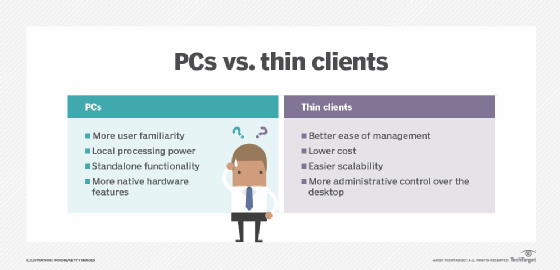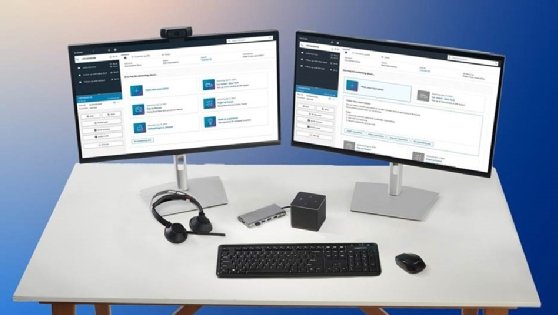Amazon thin client spurs conversation about replacing laptops
AWS bowed a new entry into the thin client space, which appeals to a limited audience of Amazon WorkSpaces-based orgs. What we really want is to ditch the work laptop for good.
Amazon came to the thin client party this week when it introduced the Amazon WorkSpaces Thin Client. But as cloud computing becomes the norm and chips become more powerful by the month, it's time to revisit an ages-old question: Can we now, finally, get rid of our work laptops?
Spoiler alert: Experts replied with a resounding "no," for the most part. Gartner analyst Sid Nag offered an "it depends," with caveats.
But methinks we are getting closer. Cloud application deployments, the engines that drive thin clients, are de rigueur. Even slow CPUs can work fast when a remote server does the data processing. These trends might pave the way for a laptop-less future just beyond the horizon.
Forrester Research analyst Andrew Hewitt said for that to happen, always-on connectivity will have to become a reality for providers, not just a goal. Also, new interfaces must emerge, such as voice input or wearables, that will enable workers to shed the mouse and keyboard and work more efficiently -- with less hardware.
"The interaction mode is going to have to change [and] the networking capabilities will have to be much more ubiquitous going forward if we're talking about a full laptop replacement," Hewitt said.
Today, thin clients can replace laptops for some workers, provided the connectivity is there.
"It serves a really good use case for a lot of businesses," Hewitt said. "If you have a great internet connection, the platforms are advanced enough that it is pretty much indistinguishable from a laptop experience. You're going to be able to have the computing power that you need, have access to all the applications, and you can run it on any operating system."

Laptops a heavy burden
In the early '90s, some workers, including my own bosses, had to schlep around early Macintosh SE/30s -- with that heavy, built-in glass picture-tube monitor -- in a bag. The rig topped 20 pounds, counting the keyboard and mouse. Some others lugged IBM and Compaq "portable" pre-laptops in their aluminum cases, which weighed more than 30 pounds. As a cub reporter, thankfully, I was too low on my employer's org chart to deserve one of these $5,000 boat anchors. Notebooks -- the paper kind -- and pens were so much lighter.
Until a few years ago, carrying a work laptop around was as fun as carrying a box of rocks, and it still kind of is. Apple impressed us with the 4.4-pound Duo in the 1990s, because everything else the average person -- or business -- could afford weighed more.
Today's touchscreen ultrabooks from HP, Asus, Dell, Lenovo and others make the Duos look burdensome in comparison. Often made with tough, lightweight aircraft-aluminum chassis and weighing 2.5 pounds, ultrabooks also typically come equipped with terabyte solid-state drives that supplant heavier hard drives.
But ultrabooks represent the state-of-the-art consumer or executive laptops. They're too high-end and expensive to deploy for the enterprise rank and file.
Chances are, if you work from home, it's on a workhorse Dell Latitude laptop, pervasive in the business world, or one of its Lenovo or HP cousins. It likely weighs upward of 3 or even 5 pounds, with its plastic case and hard drive, like the 1990s Duos. They are designed to run forever with minimal IT maintenance, not to save our rotator cuffs as we run through airports on business trips.
Manufacturers such as Microsoft, Dell, Lenovo and HP have also released hybrid tablet-PCs. Some have tablets that detach from the keyboard (called detachables), and some don't (convertibles). The tablets typically run on Windows or Android. These devices appear to be catching on in verticals where work is split between desk and other locations, such as healthcare; hospital caregivers can take the tablet on the go and connect back to the keyboard to update patient files at their desks.
Detachables and convertibles look interesting, but are uncommon in most business settings. If you dumped truth serum down the gullet of an IT buyer and asked them why, they'd probably list the usual reasons: They cost too much, they require different or additional maintenance, or they don't serve a business need the workhorses already fill.
What those of us who want to ditch the laptop need is a lightweight, secure touchscreen tablet loaded with all our work-mandatory apps. At home, we need a thin client that can drive a monitor or two, a keyboard, and a mouse. Better yet, something ultralight but ultracheap compared with ultrabooks. Best of all, a device that does both. Is that really too much to ask?
No, it's not, Gartner's Nag said. He expects Google to release a Chromebook-based thin client device that works on Google Workspace, and for Microsoft to release a similar thin client Surface that works with Microsoft 365. They might not be called thin clients, but definitions blur as technology marches on. Effectively, they and the Amazon WorkSpaces Thin Client will perform the same thin client jobs.
Dell and HP both offer thin client hardware. With Amazon stirring the pot with its tiny-in-comparison device based on the Fire TV Cube, expect those sleeping hardware giants to catch up and release something smaller and nimbler than what they offer now.

AWS thin client begins the next phase
The Amazon WorkSpaces Thin Client has a lot of pros for IT teams: They're small, secure, easy to commission and decommission. They're way cheaper than laptops, so if one gets damaged or doesn't get returned, there's less capital to lose. They can be fully controlled -- think updates, identity provisioning, apps -- from the server side. They are more secure than laptops for a number of reasons: Most importantly, end users store no data whatsoever on them.
The Amazon thin client has the mixed advantage and disadvantage of being tethered to the AWS cloud and Amazon WorkSpaces. That's a good thing for newer SMBs that run their businesses on that particular cloud.
But Amazon WorkSpaces is only used by about 1% of businesses, more or less depending on who's counting. In comparison, market researchers mostly agree Google and Microsoft own about 66% to 70% of the collaborative workspace market. Seventy other companies including AWS battle for the remaining share.
Thin clients in general have problems that need to be ironed out, beginning with limited processor power in a technology environment that requires -- or soon will require -- edge AI processing. That would seem to be the antithesis of "thin."
Then there are the RISC chips that Qualcomm, Microsoft and Nvidia are developing. RISC processors already handle the computing for your smartphone, your tablet and your car's computer. But Windows is a whole different animal; it requires heavy computing, and its architecture doesn't lend itself to RISC chips -- and likely will never, said longtime enterprise chip observers including Gartner analyst Alan Priestley and TechTarget's Senior Technology Editor Stephen Bigelow.
For now, the potential is there for a laptop-less world, but the pieces still haven't come together to create something light enough, fast enough or cheap enough to do it all in one device.
Forrester's Hewitt said to watch Microsoft's next move. The company's investments in Windows 365, Azure Virtual Desktop and the Windows 365 Cloud PC -- which runs directly from a browser -- point to something big coming.
"Windows is obviously still dominant," Hewitt said. "The vast majority of the market share today in the enterprise is still Windows, but to say that Microsoft's not thinking about this fundamental transition of bringing client computing to the web would certainly be false ... [Those investments are] an attempt to really modernize the Windows platform and make it accessible from anywhere. They see that vision."
Don Fluckinger covers digital experience management, end-user computing, CPUs and assorted other topics for TechTarget Editorial. Got a tip? Email him.







